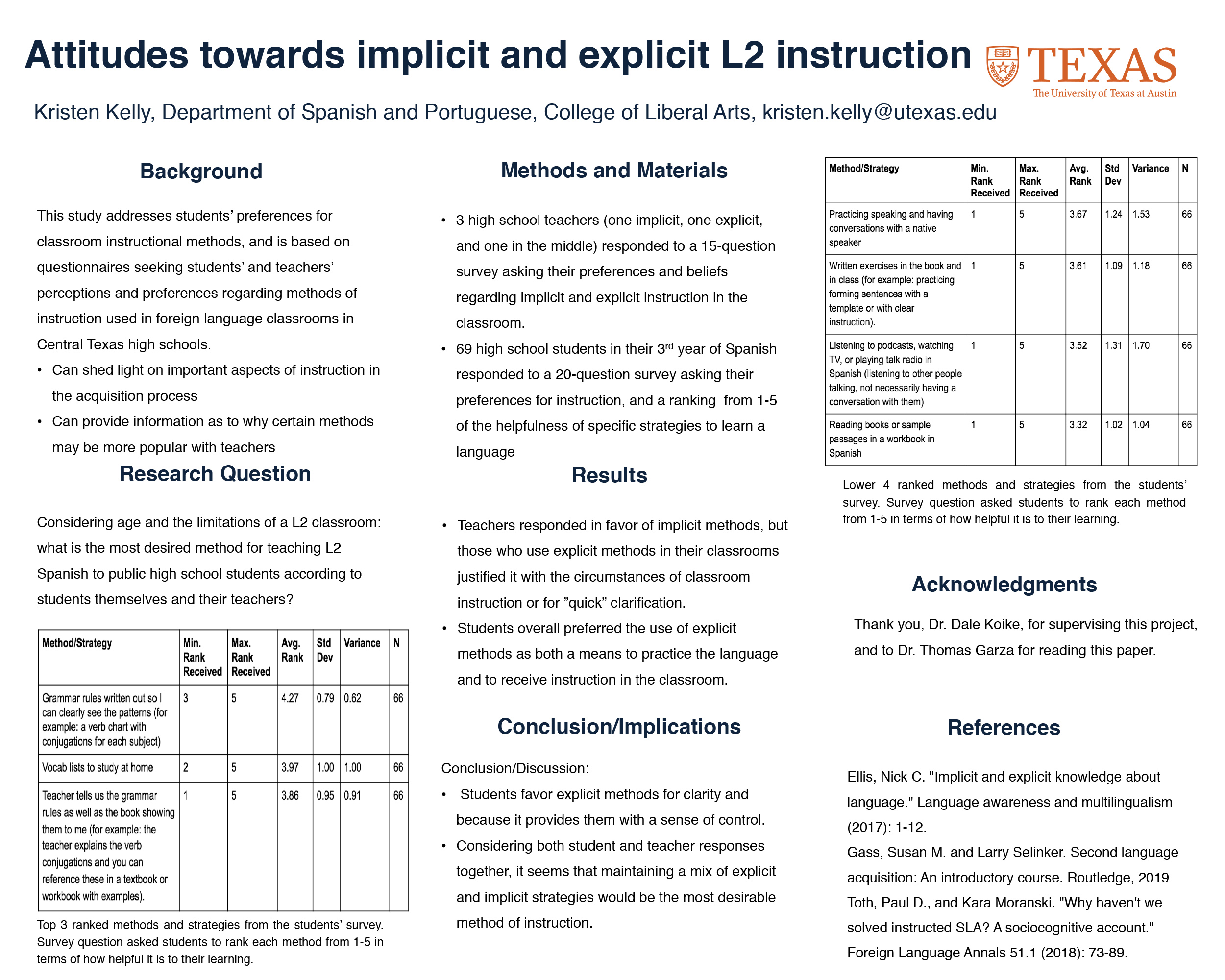Kristen Kelly, Dr. Dale Koike, Supervisor, Dr. Thomas Garza, Reader
Students in the US usually begin studying a second language (L2) at the end of middle school or the beginning of high school, with instruction primarily in 1.5-hour class periods every other day or 45-minute class periods daily. Due to time restrictions and standardized exams and objectives for public schools, public school L2 classroom instruction is very different from learning through immersion or learning a language since infancy. Considering age and the limitations of a classroom, this study addresses which method for teaching L2 Spanish to high school students is most preferred according to L2 students themselves and their teachers. This study addresses a gap in research on students’ preferences for classroom instructional methods, and is based on questionnaires to gather information from students and teachers, seeking their perceptions and preferences regarding the methods of instruction used in foreign language classrooms in Central Texas high schools. The questionnaires aimed to compare preferences, specifically regarding implicit and explicit L2 teaching methods (cf. Andringa and Rebuschat, 2015), asking (1) students about the practices that they feel are most beneficial and (2) teachers about their justification for and experiences with teaching implicitly or explicitly. Understanding the reasons underlying why students prefer a certain method of instruction can shed light on the important aspects of that instruction in their acquisition process. Additionally, exploring the reasons a teacher may prefer one method over another can provide information as to why certain methods may be more popular. Results from the questionnaires showed that students in general prefer explicit teaching styles because they feel more confident in their knowledge and usage, whereas teachers see in their experiences that implicit methods elicit greater comprehension and overall L2 abilities. The findings have implications for L2 teaching curricula design.

Comments
This is a great topic that is timely, and you should follow it up. It makes me wonder if the high school students view language learning in the same way as university students, and what parts of the curriculum could be modified to please both students and teachers. Great job! – Dale Koike
This is a very interesting topic. It is interesting that students prefer explicit instruction in foreign language acquisition, do you think that the age that we begin foreign language teaching in the US has anything to do with that? – Megan Offsie
I think it definitely is a factor, in my personal experience teaching in high schools I feel like older students want their learning to be more explicit in general so they know exactly what they need to be doing and whether they are doing it right. Age also impacts how they learn a second language, especially since they will be making connections to their first language and by the time students start a second language most of them have learned the grammar rules of English (or whatever their first language is) and they’d like to use that to make sense of the new grammar they are now learning. – Kristen Kelly
First of all, THANK YOU for providing the audio description — that was so helpful! Some of my students did a similar project a few years back, and we also found a surprisingly higher interest in explicit instruction among students compared to teachers (https://www.academia.edu/3374515/Grammar_learning_and_teaching_in_a_for…). Jean & Simard have done some interesting work on learner styles, preferences, and outcomes relating to implicit and explicit instruction that might be worth checking out. – Rob Reichle
Thank you for the comment and the recommendation, I will definitely read that. It is interesting to hear you had similar results of students being more interested in explicit instruction than teachers. – Kristen Kelly

